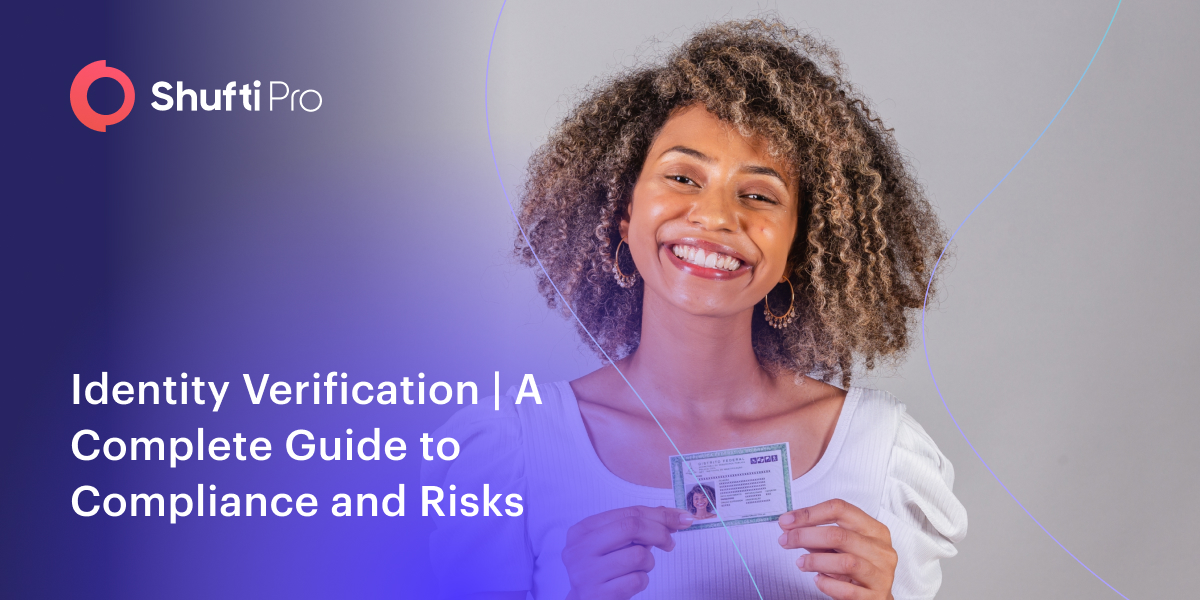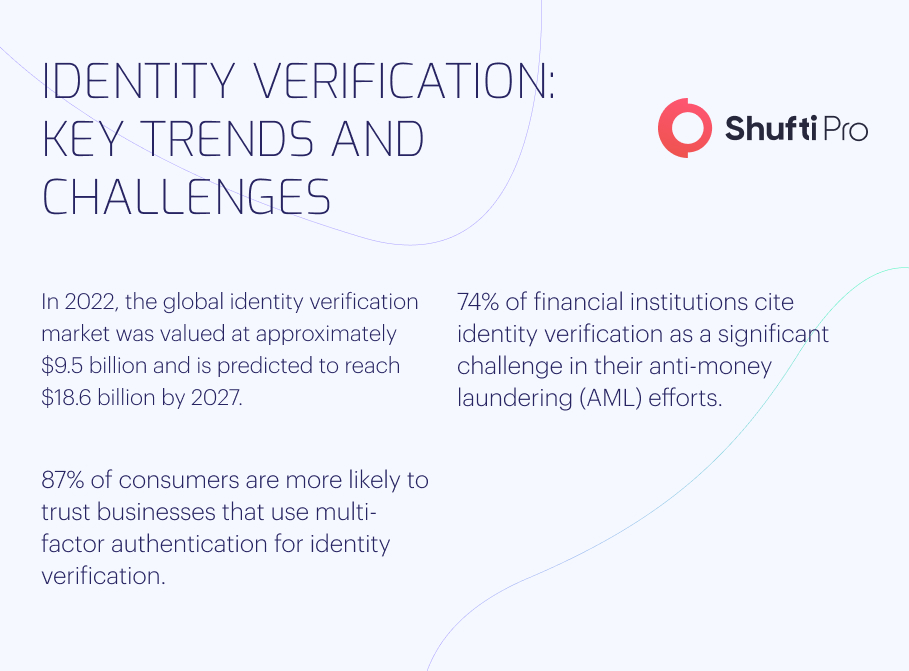Identity Verification | A Complete Guide to Compliance and Risks

The United Nations says $2 trillion is laundered globally every year. Of that, less than 10% is detected, and less than 1% of laundered funds are ever recovered. To deal with money laundering and fraud, regulations require companies to dig deep into customers’ history and conduct identity verification to make sure they are who they say they are.
Understanding the rules and regulations can prevent criminals from using businesses to launder money or conduct fraud. This can also save companies money in non-compliance penalties.
Importance of Identity Verification
Digital identity verification is vital for various reasons. For example, it’s a key strategy in combating financial crime and limiting fraud. It also has a broader economic impact as it increases trust in companies and brings stability to a country because financial crime doesn’t stop at the borders.
Many companies transfer funds across borders to create further distance and anonymity. Hence, the identity verification process is paramount in exposing these fraudsters and the corporations they may be hiding behind.
Fight Financial Crime
The most crucial benefit of identity verification is that it can help fight against financial crime. To consistently combat financial crimes, including tax evasion, money laundering, and terrorist funding, it is essential to conduct ongoing identity verification and send suspicious activity notifications to the government.
Reduce Fraud
Identity verification helps combat two pressing issues in today’s economy—synthetic identity fraud and unemployment benefits fraud. Companies may lose millions of dollars due to credit card theft. The widespread use of online stores throughout the pandemic has only exacerbated this trend.
Where a customer disputes an amount, banks charge a “chargeback fee.” This fee can range from $20 to $100 but can cost companies 2 to 3 times the transaction amount. The use of identity verification makes it much more challenging for a fraudster to commit these types of fraud.
Creating Trust Between Customers and Businesses
Customer-business relationships can benefit from the trust that is fostered through identity verification. Businesses are more likely to invest and maintain operations in a country with a reliable economy if they have confidence in the anti-money laundering checks put in place by the country’s banking system.
Lenders who conduct identity checks can safely extend more credit to customers. Identity verification allows lenders to lend more money to consumers by confirming their identities and verifying assets.
Avoid Non-Compliance Penalties
Businesses can also save money on penalties by implementing identity verification procedures. In 2019, penalties for failing to verify one’s identification cost businesses worldwide a total of $10 billion. Twelve of the top 50 banks were fined for non-compliance with KYC. Not only does the company have to pay monetary fines, but it must deal with the reputational damage that can arise from media coverage of non-compliance.
People who put money into a business or buy from it want to have faith in it. Therefore, compliance with KYC rules can result in trust and positive brand associations, which are suitable for business.
Identity Verification Standards and Regulations
The US Congress passed the Bank Secrecy Act (BSA), officially named the Currency and Foreign Transactions Reporting Act 1970. Individuals and businesses are both obligated by the BSA to preserve certain records. Money laundering and terrorism funding are only two of the many financial crimes that FinCEN was established to combat back in 1990. The USA PATRIOT Act was enacted twelve years later, significantly improving the BSA. In particular, it expanded FinCEN’s ability to get information about the beneficial owners of businesses and other financial institutions. Over 27,000 banks’ records are now included.
The USA PATRIOT Act allows FinCEN to create regulations setting out processes that financial institutions must follow for opening new accounts. This includes strategies for digital identity verification, including verifying the identity of any person who wants to open a new account to the extent “reasonable and practicable.” In 2016, they also set out additional rules for due diligence, including the obligation to verify beneficial owners.
Essential Steps to Verify Customer’s Identity
While the specific processes to confirm a customer’s identification will vary from business to business, financial institutions should know a few basics to help meet Know Your Customer requirements.
Step 1: Assess Needs
Before taking action, conduct a thorough review of needs. Businesses need to understand who customers are, what risk levels they are comfortable with, and what level of security they would like. Firms need to know the target audience inside and out to implement the most effective system. Do many of the customers are seniors who require help with new software? Do they serve a sizable international clientele?
To ascertain verification and security requirements, businesses must answer these questions. Institutions should also be familiar with the numerous forms of fraud they could encounter. Credit card fraud and identity theft are two examples of potential dangers for businesses that accept credit card payments from customers.
Step 2: Implement the Right Verification Method
Once a business defines identity services, it must find the method that works for it. Then, with the right technology at their fingertips, companies can implement a verification method that will fit the organisation’s needs. Whether looking for biometrics verification for added security or a two-factor verification system, businesses can choose the best option for ID verification services needs by working through the pros and cons.
Step 3: Inform Customers
Businesses need to ensure that their clients are informed of the adjustment. Consider implementing video tutorials and detailed guides to help them transition to the new verification process. If the customer has any issues, ensure that top-quality customer service is available for immediate access.
Step 4: Understand Customer Activities
Understanding what customers do more deeply can help organisations determine unusual or suspicious activities. This can be accomplished by setting up workflows to screen customers for different purposes. Watchlist, fraud, and business verification screening are just a few of the identity verification checks companies must consider incorporating into overarching programs.
Step 5: Analyse Customer Data with Identity Verification Software
There’s a lot of data that may not be easily accessible to verify the identity of a person or entity. A crucial initial step is to choose the best identity platform to fit business needs. However, firms need to be aware of a lot of information available. At this time, a critical initial step is to find the correct identity solution that fits business needs. Businesses will need access to an identity verifier to get started performing identity verification.
Step 6: Keep Proper Verification Records
Once a customer has been identified, a company must maintain a verification record. Make sure that businesses have updated and accessible records on an ongoing basis. Companies will want evidence supporting the verification process to avoid penalties or fines if they encounter any compliance issues.
Step 7: Leverage Customer Identity to Support Customers
Once businesses have a customer identity verification process in place, they can leverage that information to support their customers and build long-term relationships. Customers’ trust in a business and their loyalty to a specific business can be increased by demonstrating the value of their personal information security and privacy. Implementing an identity verification program is the first step towards building customer trust.

Best Practices for Identity Verification
Financial Institutions should consider certain things when implementing procedures for identity verification. These are best practices that can help make the process more efficient.
Notes for For New Business Relationships
Identity verification is essential for new business relationships. Before starting any kind of commercial engagement, it’s crucial to fulfil Know Your Customer and Due Diligence responsibilities. Business establishments should do consumer identity verification and risk profiling. This can aid in establishing norms, laying the groundwork for potential clients, and continuous auditing. In addition, having a uniform framework makes any discrepancies stand out, making it easier to identify and report questionable behaviour.
Dealing with false positives can take a lot of work. Choosing identity verification services that help to reduce false positives will support business in the long run. The initial work to establish a risk profile by implementing a thorough due diligence process at the start of the process can set the foundation for a solid and successful business relationship. The company should handle this at the beginning of each commercial engagement. At this stage, the company must conduct additional due diligence if the customer needs to provide sufficient documentation.
As part of the strategy for minimising risk, think about the physical location of data storage facilities. While it must be a digitally secure location, businesses should easily access the customer’s risk profile in case of future regulatory audits.
Best Practices For Current and Ongoing Relationships
Monitoring is a necessary part of risk management for current and ongoing relationships. This means reviewing transactions on an ongoing basis to ensure that they match the risk profile. If certain transactions don’t fit the risk profile, they must check them in more detail. Companies also need to stay responsive to suspicious factors that may require them to change the risk profile for the customer. Finally, ensure all documents and data are recorded and kept for easy access.
Special Transactions to Note
Not all transactions are the same. However, companies can better tackle money laundering by adopting some general principles of enhanced due diligence. In this way, they will not get overwhelmed by the KYC and reporting obligations.
Large Transactions
Companies should take extra due diligence when going through large amounts of money transactions. FinCEN reviews these transactions regularly. Companies don’t want to be offside of any rules because they don’t take extra care when dealing with these large transactions.
With cryptocurrency, this is an even more critical step because of the anonymity offered by cryptocurrency. The federal government is spending more time auditing and reviewing cryptocurrency transactions. Companies should take extra care because any suspicious activity can lead to significant reputational damage for the company.
High-Risk Countries and PEPs
Any transactions from high-risk countries or politically exposed persons have a higher money laundering risk. For these customers, companies must get additional forms of identification. Companies should also identify the source of finances or wealth. They must ask more questions to understand the purpose of the transaction.
Identity Verification for Risk and Compliance
Companies operating in regulated industries must implement identity verification and Know Your Customer (KYC) procedures. Customers must be thoroughly screened to identify and exclude potential criminals and other negative actors.
And while each organisation will have a slightly different system for identity verification, the goal is ultimately to reduce fraud and avoid hefty fines. When thinking about identity verification for an organisation, remember these vital final notes:
- Identity verification aims to prevent criminal activity like fraud and money laundering. It’s a good way to make sure a person is who they say they are.
- Suppose a business is legally required to have a process for identity verification. In that case, it is paramount that firms implement the correct procedures and file the necessary reports to stay compliant. If the system does not comply with the requirements, the company will be hit with a painful and expensive fine.
- There are tools available to help implement identity verification programs. These tools can save team time and help to provide a better customer experience during onboarding.
- An identity verification solution that allows automation of decisions will help approve more customers faster and increase top-line revenue.
How can Shufti Help
Shufti can be a valuable asset for identity verification needs. With our cutting-edge technology, we offer instant customer identity verification featuring advanced behaviour-based anti-spoofing detection. Our services span across 230+ countries, ensuring extensive global reach. We employ an efficient 2+2 verification approach and support multilingual OCR extraction, covering over 150 languages. Our platform is equipped to detect synthetic identity fraud and provides an impenetrable facial authentication fortress. Trust Shufti to enhance identity verification processes with accuracy and security.
Inquiring minds need to know how exactly Shufti helps businesses verify identity.










